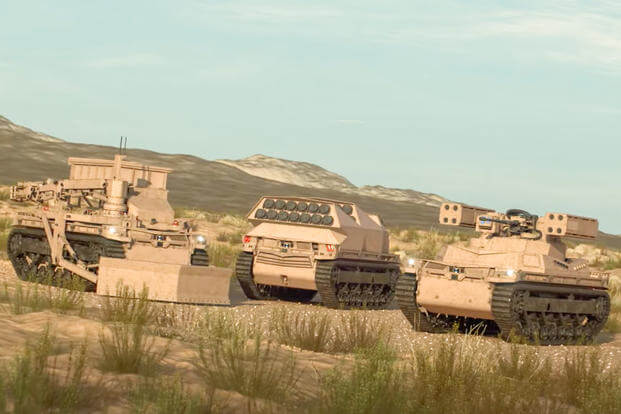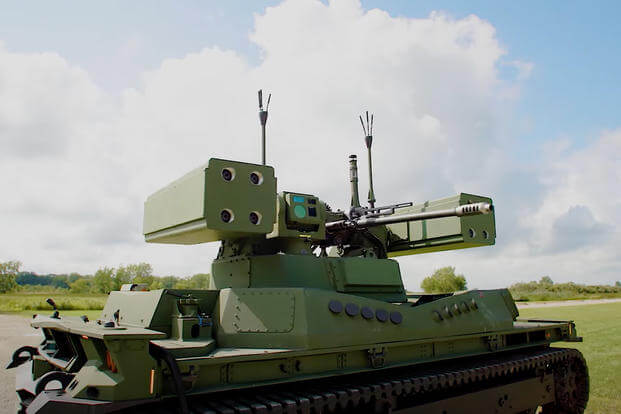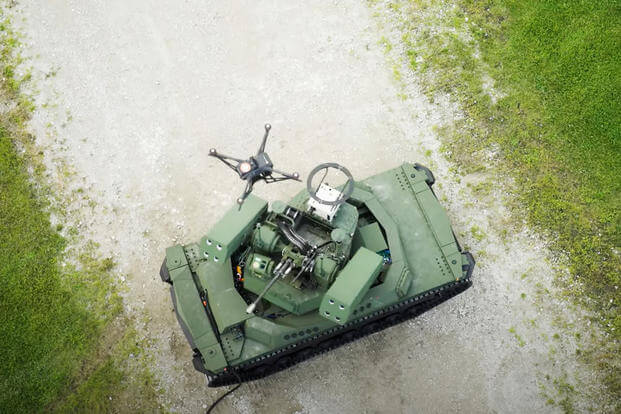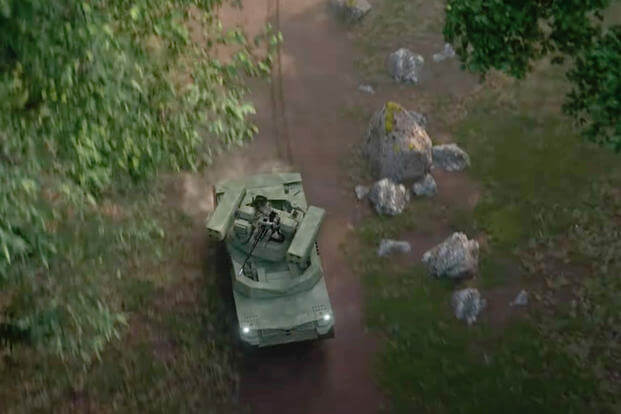Editor’s note: This is the first in a four-part series on the Army’s Robotic Combat Vehicle program.
General Dynamics Land Systems isn’t a household name, but the defense manufacturer is one of the first places the U.S. military calls when current events inspire a bit of retail therapy.
Some of the tracked vehicles GDLS currently builds include the legendary M1 Main Battle Tank and the Army’s new “assault gun,” the M10 Booker Combat Vehicle. There are wheeled options, too, such as the Stryker infantry carrier vehicle and four variations of the Light Armored Vehicle (LAV). The U.S., Canada, United Kingdom, Saudi Arabia and other nations in the Middle East and northern Africa comprise GDLS’ customer base.
It’s safe to say the company knows a thing about making armored combat vehicles. But these days, GDLS is working on something new. It has armor and tracks, but something is conspicuously absent: the crew.
What Is the RCV Project?
The Army has been working on the Robotic Combat Vehicle program since 2019 with the original goal of acquiring three classes of unmanned vehicle — light, medium and heavy — to accompany manned units into combat. These remotely operated vehicles will allow soldiers to investigate suspected ambush areas and protect their flanks without putting lives at risk.
In recent years, the RCV program has “transitioned from a family of light, medium, and
heavy variants to a single vehicle approach with a common chassis,” according to a 2024 report from the Congressional Research Service, with four companies selected in September 2023 to deliver prototypes to the Army for testing and evaluation.
“Human-machine integrated teams are the future of successful ground combat in the land domain,” Brig. Gen. Geoffrey Norman, director of the Next Generation Combat Vehicles Cross-Functional Team, said, according to an Army release at the time. “Bringing RCVs into our formations will give our Soldiers new capabilities to fight and win with the changing character of war.”
One of those vehicles is the GDLS TRX, the first prototypes of which the company recently delivered to the Army.
Why the TRX (Concept) Is Awesome

The TRX (which stands for Tracked Robot, 10-ton, and bears no relation to the Ram TRX that Stellantis discontinued because suits hate happiness) was originally designed to compete in the RCV-Medium class.
As the Congressional Research Service reports, the selected vehicle will weigh from 10-20 tons and measure no more than 230 inches long, 107 inches wide and 94 inches tall so it can travel inside a C-130. It must be capable of defeating light to medium armored threats, and the Army intends for it to survive combat (unlike the RCV-Large, which is considered disposable).
On paper, the TRX checks all the boxes. GDLS enhanced the design with artificial intelligence. The vehicle uses lightweight materials to make it faster and more efficient. The hybrid-electric powertrain squeezes more miles out of every drop of fuel while adding the ability to maneuver almost silently. And according to a GDLS release, the TRX can carry its own weight in payload and accomplish a huge range of missions.
The TRX uses a modular deck system that lets forward units configure it to suit the mission at hand. One option, as Breaking Defense points out, is a system that includes two Longbow Hellfire missiles, four Stinger missiles, a 30 mm chain gun and an M240 machine gun.
“TRX provides superior performance as an enabling technology in critical battlefield roles, including direct and indirect fire, long-range loitering munitions, short-range air defense, counter-uncrewed aerial systems, autonomous resupply, complex obstacle breaching, electronic warfare and reconnaissance,” Gordon Stein, General Dynamics Land Systems vice president and general manager for U.S. operations, said. “It is designed to provide increased situational awareness and lethality to enable Army maneuver and combat support formations to win decisively through cutting-edge human-machine integration.”
Don’t Get Too Excited About the TRX Just Yet

If all this sounds good enough to sign on the dotted line, take a knee and drink some water. The Army selected GDLS to compete for the RCV contract in 2023, so there’s a long road ahead.
There’s going to be stiff competition, too. The Army selected prototypes from HDT Global, Oshkosh Defense and Textron Systems to compete for the exciting — and lucrative — contract. The total value is nearly $25 million, according to the Army’s prototype agreement.
There will be multiple phases of testing to identify any weak points or significant advantages of the vehicles in contention. According to the Congressional Research Service, the Army plans to select a winner in fiscal year 2027 and field the first units in FY 2028.
The TRX might have what it takes, and it’ll have to prove its worth if GDLS is going to end up on top.
Brace Yourself for the Battlefield of Tomorrow

One of the challenges the RCV program faces is a battlefield that seems to change by the day. In recent months, North Korea deployed 250 conventional missile launchers, Houthi rebels in Yemen launched a sophisticated attack on a container ship in the Gulf of Aden, and the war in Ukraine continues to be a mashup of weaponized hobbyist drones and F-16s. Tomorrow, U.S. service members could find themselves fighting standing armies in a conventional land war or dodging homemade explosives in a counterinsurgency.
The threats take many forms, but a few truths remain the same. Flexible weapon systems provide more pathways to victory. It’s better to lose an unmanned vehicle than a manned one. If the TRX makes it to the front lines, soldiers will be glad it’s there.
Want to Know More About the Military?
Be sure to get the latest news about the U.S. military, as well as critical info about how to join and all the benefits of service. Subscribe to Military.com and receive customized updates delivered straight to your inbox.
Story Continues
Read the full article here

